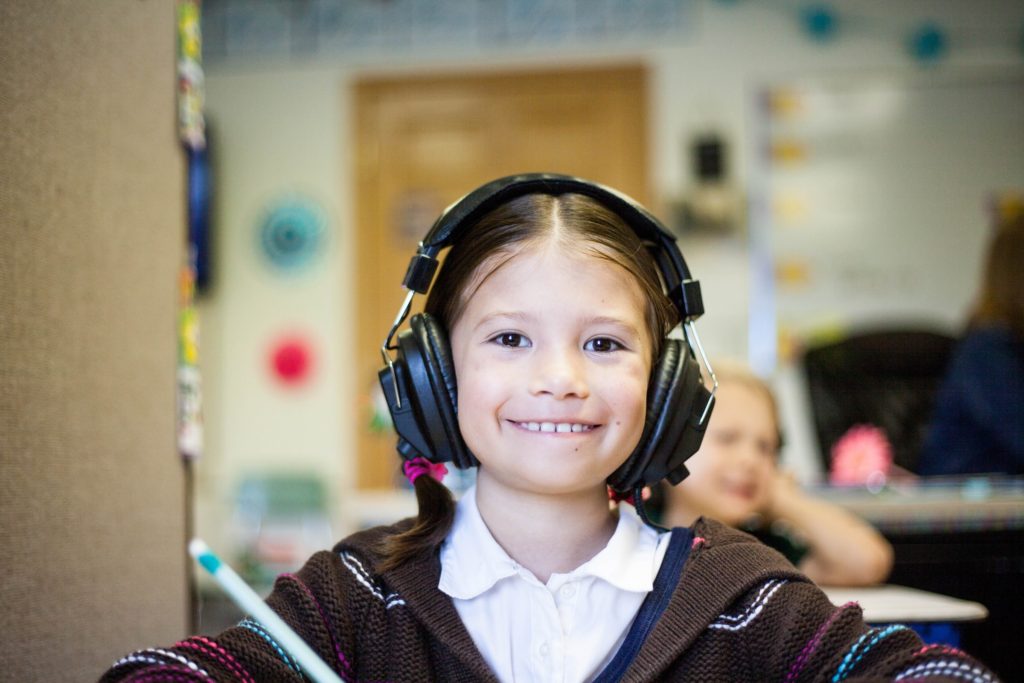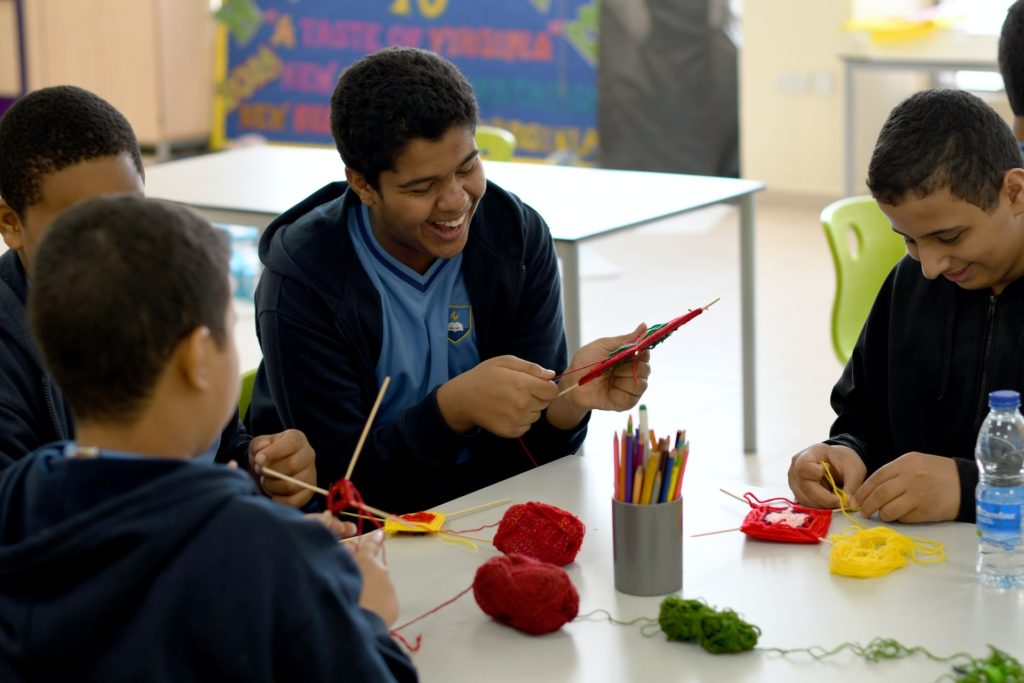Humans have an incredible ability to process a vast array of sensory information and not be overwhelmed. Despite the constant assault of visuals, sounds, and sensations, the brain is able to select the most important information and focus on that. This is particularly evident in the brain’s auditory system.
Even in a crowded party with multiple voices speaking, a partygoer is able to have a one on one conversation and block out all the other voices, noises, and other distractions. Recent research into this phenomenon may hold secrets to helping students to focus and pay attention better in class.
Despite this ability to focus, the brain still has to work extra hard to inhibit and block out the extra sensory information as well as process their conversation partner’s voice with extra steps. This ability takes practice to develop and isn’t equally easy for everyone. Some people may be more sensitive to distracting noises while others may seem to not even notice distractions.
Students in school have ample opportunities to develop this ability with all of the other people and noises surrounding them. While students taking a test should be able to block out some amount of noise, such as pencils scratching or coughing, others may struggle to be able to focus.
This can be a hindrance to their ability to do their best as they can’t always expect total silence when they need to focus. Helping students to focus and pay attention doesn’t always involve the teacher removing distractions, but instead helping students to slowly build their resilience of focus when working.
New Research on Focus and Attention in the Brain

Researchers out of the University of Rochester published a study recently looking at the mechanisms involved in the human brain’s ability to focus on listening to a speaker when there are multiple conversations going on simultaneously.
The researchers had participants hooked up to EEG while they listened to two different audio clips at the same time. The researchers set up the sound so that one sounded as if it was coming from one side of the participant while the other came from their other side in order to simulate multiple conversations going on like how a person would experience during a party.
The participants were told to focus on one or the other story, avoid moving, and focus on a single visual point. This was meant to lower distractions and focus the study on the effects of the interfering audio stimuli rather than including touch and visual stimuli as well. The audio that was played for them was a series of clips from two stories by Sherlock Holmes, one by a male narrator and one by a female narrator. After all of the audio clips concluded the participants took a short quiz to test how much they had retained.
The researchers found that only the story that was focused on was processed as language while the unattended story was processed as a simple auditory stimulus, but not moved into language centers for further processing. “The capacity of the brain to process information from multiple streams at any given moment in time is limited,” but attention plays a major role in what information is processed and how well it is remembered. (Teoh et al.)
How to Help Students to Focus and Pay Attention in Class
While these findings aren’t necessarily groundbreaking for teachers, it does give credence to the need for students to be able to sit quietly, focus, and listen carefully to the teachers instructions. Attention is limited and so must be a major focus for teachers so that they don’t waste their time and effort speaking to students who aren’t even processing their instructions as language because they’re busy focusing on another conversation.
Attention plays a major role in understanding and actually processing what is being said, however students who are paying attention will be able to do so even if there is significant distraction around them.
While this may suggest that a very traditional classroom where students sit quietly in rows and never move is best for helping students to focus and pay attention, this isn’t actually the case when the results of this study are connected to other research on attention. Attention is not only limited in how much can be processed at one time, previous attentional research shows that it can only be held for a very limited time as well. Teachers need to not only keep in mind how much they’re expecting students to focus on, but also how long they’re expecting that focus to be held.
Teachers should try to be as efficient as possible with their lectures and instructions so that they can utilize the attentional resources of their students most effectively. Students need to be quiet, still, and focusing carefully when the teacher is giving instructions or a brief lecture, but teachers need to be very mindful about how long their lectures are and how quickly their instructions are given. The teacher should have good quieting and transition practices so that students are able to focus on what needs to be said, and then the teacher should have what they want to say well planned and efficiently organized.
Before quieting students down, teachers should write instructions on the board so that students not only have the auditory information they can focus on, but they also have a place to visually focus. Not only does this limit visual distractions, but this also acts as another sensory pathway for their brains to process what they’re supposed to do.
Teachers also are all well aware that it is impossible to get every single student to focus perfectly. Writing the directions on the board before speaking also allows students who weren’t paying attention to have a place to catch back up without admitting to the teacher that they weren’t paying attention.

Generally, when taking a test, students should be quiet and focused so that they can pay attention and focus on answering test questions. This will remove distractions and help more sensitive students not be bothered by noises, especially during a high stress time.
However, another thing for teachers to keep in mind is that this ability to ignore distracting stimuli is a skill that the brain can get better and better at. Students can’t expect complete total silence as there will be pencils scratching, people coughing, and maybe a student whispering a question to the teacher. They need to learn to block out the offending stimulus so that they can focus on what they’re doing.
In the real world, it can be very hard to find a silent place to get work done and depending on the career chosen, they may need to be able to focus even with a lot of noise present. Students who have actively learned to improve their focus and get work done will be better prepared to ignore the distractions of life and not let things get to them.
While some students get special accommodations to take tests in private quiet rooms, this practice will actually act as a crutch, holding up their weakness, but not actually strengthening their abilities long term. The best practice is to find a balance between supporting and pushing these students so that they don’t fall apart due to stress, but also are prepared for when life no longer offers accommodations in adulthood.
Finding this balance is difficult, and in some cases when the test is serious and the student is overwhelmed, it may be best to let them have their accommodations, but when the test or quiz isn’t a big deal, it may be best to push them to work on their weaknesses rather than cushioning them from things the real world will not.
In the end, helping students to focus and pay attention is a balancing act between pushing their brains to develop and adapt without pushing them to overload. Teachers need to use their professional experience and personal rapport with their students to make good decisions about when enough is enough or when students really need to learn to push through. Students need to work on their focus in order to handle a chaotic world after graduation, but teachers also need to provide a safe and structured place for students to learn.
Want more like this? Make Lab to Class a part of your weekly professional development schedule by subscribing to updates below.
References
Teoh, Emily S. et al. “Attention Differentially Affects Acoustic And Phonetic Feature Encoding In A Multispeaker Environment”. The Journal Of Neuroscience, 2021, pp. JN-RM-1455-20. Society For Neuroscience, https://doi.org/10.1523/jneurosci.1455-20.2021.



